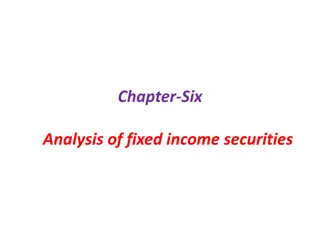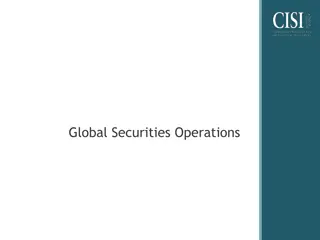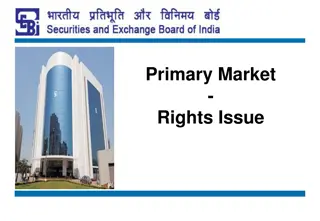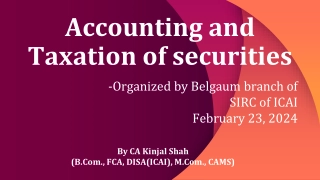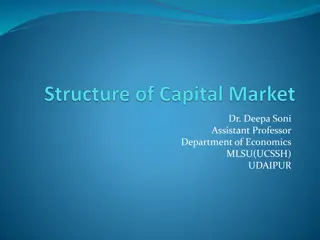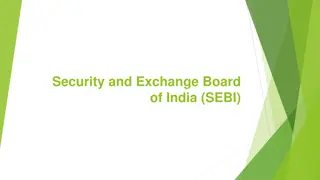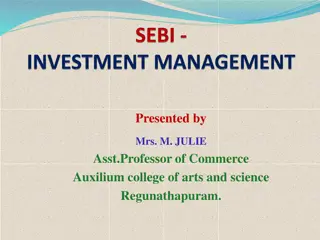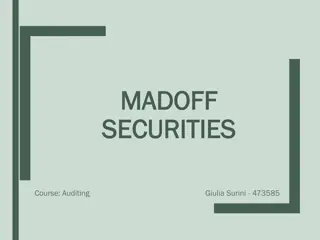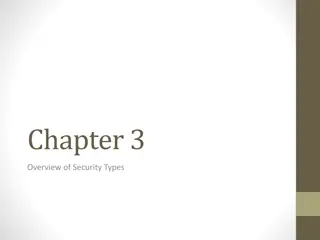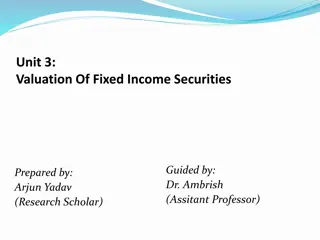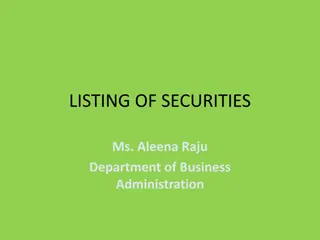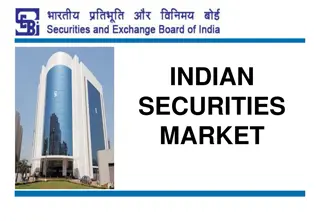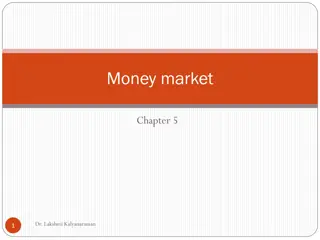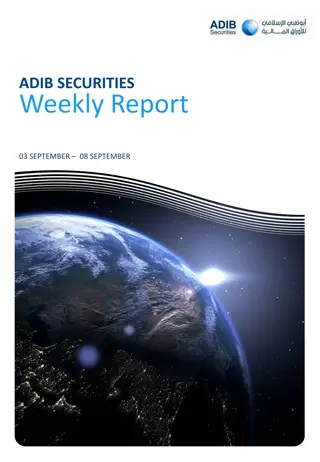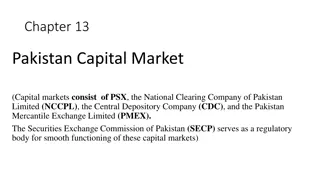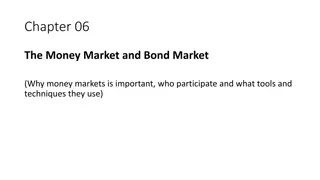Understanding Dematerialisation in Securities Market
Dematerialisation is the conversion of physical securities into electronic form, making it convenient and secure for investors. This presentation covers the process, prerequisites, and steps involved in dematerialising securities, along with examples of securities that can be dematerialised. It also provides information on how to check company status and the necessary documentation required for dematerialisation.
- Securities Market
- Dematerialisation Process
- Electronic Securities
- Investor Education
- Financial Awareness
Download Presentation

Please find below an Image/Link to download the presentation.
The content on the website is provided AS IS for your information and personal use only. It may not be sold, licensed, or shared on other websites without obtaining consent from the author. Download presentation by click this link. If you encounter any issues during the download, it is possible that the publisher has removed the file from their server.
E N D
Presentation Transcript
Depository Services (Available to demat account holder)
Disclaimer Disclaimer Information contained in this presentation is as on September 30, 2022. The information contained in this presentation is only for Educational and Awareness Purposes related to securities market . This presentation is only for Educational and Investor Awareness Programs and shall not be used for any legal interpretations. SEBI or Stock Exchanges or Depositories shall not be responsible for any damage or loss to any one of any manner from use of this material. Suggestions or feedbacks, if any, may please be sent by mail to visitsebi@sebi.gov.in. 2
Flow of Presentation Dematerialisation of Securities Transposition of Securities Rematerialisation of Securities Transmission of Securities 3
What is Dematerialisation? Conversion of physical securities into electronic form. Some examples of securities that can be Dematerialised : Equity Shares Preference Shares Debentures Bonds Mutual Fund Units Government Securities Sovereign Gold Bonds 5
Dematerialisation : Prerequisites Investor should have a Demat account with any Depository Participant (DP) Securities should be available for Dematerialisation (active ISIN): Company Details whose securities are available for Demat is available on websites of Depositories - CDSL : https://www.cdslindia.com/Investors/InvestorCorner.aspx - NSDL : https://nsdl.co.in/master_search.php Details of Registrar and Transfer Agent (RTA) of company available on Investor Relations section of the Company website 6
Dematerialisation : Check Company Status (Sample) Checking company status on NSDL website Checking company status on CDSL website 7
Dematerialisation : Process Broad Process : Submit DRF and physical certificates to DP Obtain Demat Request Form (DRF) from DP Fill DRF properly and sign Care to be taken : DRF should be signed by all holders (in case of multiple holders) Pattern of holdings in the certificates should match with Demat account Separate DRF should be submitted for - Each ISIN (meaning of ISIN in later slide) Free and locked in securities Securities locked-in for different reasons and different lock-in release dates 8
Dematerialisation : Meaning of ISIN International Securities Identification Number (ISIN) Allotted by NSDL in India for all securities except Government securities Unique Identification Number for Each Security Same ISIN used by both depositories Contains 12 Characters Example of ISIN -IN E 005A 08 02 0 Check Digit IN stands for India Serial No./ Type of Instrument. E stands for Company. 08 for Security Code 005A for Company Identity F stands for Mutual Funds 9
Dematerialisation : Sample Physical Security Stamp of Compan y Stamp of DP with DP ID and Client ID details 10
Dematerialisation : Sample Demat Request Form (Equity shares) Put Folio Number Put Numjber of Securities and Total Refer Physical Certificate for Certificate Nos and Distinctive Nos. 11
Dematerialisation : Sample Demat Request Form (Equity shares) Signatures provided in boxes for Signature with DP and Signature with RTA / Issuer / Company should exactly match with signatures provided to DP and RTA / Issuer / Company earlier. 12
Dematerialisation : Sample Transaction Statement showing Credit of Dematerialised Shares Unique ID of DP in the system of the depository Unique ID of investor in the system of the depository Name & Address of investor Regd Email ID of investor Regd Mobile No. of investor 13
Dematerialisation : Mutual Fund Units Following Mutual Funds have the option to convert/ subscribe to Demat Form: - - - All existing mutual fund units issued by all the mutual fund companies. All New Fund Offers (NFOs). All existing mutual fund investments through SIP mode ISIN of your mutual fund units - Can be seen in the Statement of Account / Consolidated Account Statement (CAS) Can be searched at website of CDSL/NSDL. - Investor needs to submit a Conversion Request Form along with Self Attested Statement of Account received from Mutual Fund to the Depository Participant (DP). 14
Dematerialisation : Sample Demat Request Form (Mutual Fund Units) 15
Dematerialisation : Sample Demat Request Form (Mutual Fund Units) Signatures provided in boxes for Signature with DP and Signature with RTA should exactly match with signatures provided to DP and RTA earlier. 16
Dematerialisation : Rejection of Demat Request Form (DRF) Some common reasons for rejection of DRF : Incorrect Holder(s) name Certificate details mismatch Demat request initiated under wrong ISIN Transmission Form / Death Certificate not submitted DRF not signed / stamped by DP Signature mismatch Verification of Share Certificate(s) not received from RTA within prescribed timelines Mismatch between actual quantity of shares and quantity of shares mentioned in DRF Shares under stoptransfer / court injunction Certificates submittedAllotment / Call Payment receipt not attached are reported as stole Duplicate certificates already issued Old defunct certificates surrendered for Demat Forfeited securities surrendered for Demat Forged endorsement on certificate 17
Dematerialisation : What to do if Demat Request is rejected ? Steps to be taken after rejection of DRF : Issuer / RTA sends an Objection Memo containing reasons of rejection of request Investor can see transaction status in statement of transactions. DP informs investor about rejection of Demat request. Finally, Submit the request for Demat once again through DP. Investor needs to rectify the errors / remove deficiency in the documentation 18
Transposition Form When Transposition Form needs to be submitted?: - For rectification of order of names of Joint Demat Account holders. - When order of names of joint shareholders on the physical share certificate is not same as the order of names on Joint- Demat account. - Transposition form will have to be signed in the same order as on the Joint Demat account. 20
Transposition : Sample Application Form for Transposition (TRPF) (1/3) Client ID of Joint Demat Account Ref to Demat Request Form Names of investors and order of names must be exactly matching with that in Demat Account 21
Transposition : Sample Application Form for Transposition (TRPF) (2/3) 22
Transposition : Sample Application Form for Transposition (TRPF) (3/3) Signatures provided in boxes for Signature with DP and Signature with RTA should exactly match with signatures provided to DP and RTA earlier. 23
Rematerialisation What is Rematerialisation? Conversion of securities held in Demat form to physical form Pre-requisite of Rematerialisation Sufficient Balance of Securities in Demat Account. Process Submit Remat Request Form (RRF) to DP RRF should be signed by all holders (for multiple holders) Separate RRF should be submitted for - Each ISIN Free and locked in securities Securities locked-in for different reasons and different release dates 25
Rematerialisation : Sample Remat Request Form To be filled by the DP 26
Rematerialisation : Sample Remat Request Form (Lock-in) 27
Rematerialisation : Rejection of Remat Request Form (RRF) RRF details mismatch with electronic request Incomplete or incorrect RRF Non receipt of RRF by Issuer / RTA Investor may make corrections and Re-Submit the RRF 28
Transmission 29
What is Transmission? Meaning : - Securities owned by a person who has died are transmitted to his legal heirs. Legal heirs need to submit necessary documents: - Notarized death certificate - Notarized Succession certificate - Notarized copy of the Probate or Letter of Administration, etc. Transfer brought about - By operation of law. Investor to get two options regarding nomination To provide nomination in the prescribed form up to three person along with their percentage Opting out of nomination through prescribed declaration form Folios/Account to be freezed if none is opted till March 31, 2023 30
Transmission Procedure Steps for Transmission Surviving joint holder/s, nominee or legal heirs of deceased account holder to approach the Depository Participant (DP) For shares held in physical form - Approach each Company and their respective RTAs. 31
Transmission : Documents to be submitted (for Individual accounts) (1/3) Account Holder Documents Required - Copy of Death Certificate duly attested by a Notary Public or by a Gazetted Officer. Surviving Holder (s) in a Joint Account - Copy of Death Certificate duly attested by a Notary Public or by a Gazetted Officer. Nominee of Deceased - If Demat Account of claimant is not with DP of the deceased, copy of Client Master Report (CMR) of nominee s account. (Nominee can obtain CMR from his DP) 32
Transmission : Documents to be submitted (for Individual accounts) (1/3) Account Holder Documents Required - - Succession certificate Letter of Administration / Probate of the Will (as applicable) In absence of above documents: No objection certificate(s) with indemnity/ copy of Family Settlement Deed [as an alternate to No objection certificate(s)] Attested copy of Death Certificate Affidavit Attested copy of Death Certificate Succession certificate Letter of Administration / Probate of the Will (as applicable) Value of Holding < Rs.15 lakh as on the date of application(If shares are in Demat) Legal Heir (s)/ legal representativ e(s) - [where deceased was a Sole Holder] - - - Value of Holding > Rs.15 lakh as on the date of application(If shares are in Demat)* In both the above mentioned situations, if Demat Account of claimant is not with DP of deceased, then a copy of Client Master Report of nominee s account to be submitted. Rs. 5 Lakhs if shares are in physical format 33
Transmission : Documents to be submitted (for Joint accounts) (3/3) Death of a joint holder: - Surviving holders to open a new account with the Depository in the same sequence of surviving holders. - If surviving holders already have a Demat account but in different sequence, then Transposition process along with Transmission process must be followed. Documents to be submitted: Duly filled Transmission Request Form (and Transposition Form, if applicable) Attested copy of Death Certificate 34
Transmission : Sample Transmission Request Form (1/2) 35
Transmission : Sample Transmission Request Form (2/2) 36
One Time Password (OTP) for off-market transfer and E-voting facility Off-Market Transfer: Trades which are not settled through the Clearing Corporation/Clearing House of an exchange are classified as Off Market Trades . To prevent fraudulent off-market transfer in demat account of client, One level client authentication introduced Client consent required through One Time Password (OTP) For Off-market transfer of shares in Demat account E-Voting Facility: Enabled e-voting by way of single login Through client demat account Through website of depository and depository participants Confirmatory SMS to the shareholders by depository 37
38 Additional Information Additional Information For further information, you may visit the following web-sites and Mobile App: www.sebi.gov.in/ https://investor.sebi.gov.in/ Saa Saa thi thi App App For Grievance Redressal, you may visit following website: www.scores.gov.in/ Or, you may call SEBI at following Toll-free Helpline Numbers from 9:00am to 6:00pm on all days (excluding declared holidays in the state of Maharashtra): 1800 266 7575 1800 22 7575 SEBI : HAR INVESTOR KI TAAQAT Helplines are available in 8 Languages: English, Hindi, Bengali, Gujarati, Marathi, Kannada, Telugu and Tamil 38
Thank You 39


